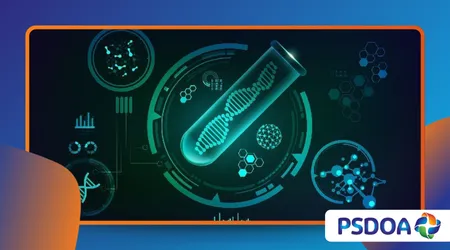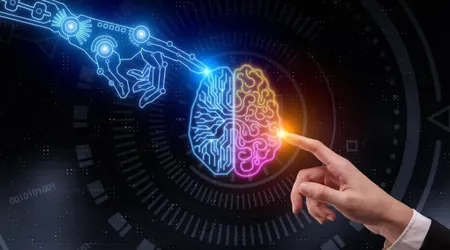How Synthetic Biology Is Creating New Life Forms

Synthetic Biology Is Creating New Life Forms, shifting the role of science from observing nature to actively engineering it.
Anúncios
This revolutionary field combines biology, engineering, and computation to design and build novel biological parts, devices, and systems that do not exist in the natural world.
It is the definitive frontier where digital code meets organic material. We are entering an era of bio-engineering where DNA is code, and cells are programmable machines.
This technology promises to solve humanity’s greatest challenges, from climate change to chronic disease, by repurposing life’s fundamental building blocks for industrial and medical use.
This is not just modifying existing life; it is true biological creation.
Anúncios
What Exactly is Synthetic Biology and How Does it Work?
Synthetic biology is essentially the application of engineering principles standardization, modularity, and predictable function to biological systems.
Researchers use techniques to read, write, and edit DNA with unprecedented speed and accuracy. They treat genes like electronic circuits.
This field allows scientists to redesign organisms for useful purposes.
The goal is to program new functions into living cells, making them perform tasks like producing medicine, cleaning up pollution, or even storing data. It is a controlled, design-first approach to life itself.
++ The Golden Ratio in DNA, Galaxies, and Architecture
How Does the Engineering Cycle Define Synthetic Biology?
Synthetic biology follows a strict engineering framework: the Design-Build-Test-Learn (DBTL) cycle. This structured process ensures reliable, predictable outcomes, mimicking how engineers create integrated circuits.
The cycle begins with Design, where genetic circuits are planned digitally using computational tools. Next, Build involves synthesizing DNA sequences in a lab.
Test verifies the circuit’s function in a living cell. Finally, Learn feeds data back into the design process, continually improving the system.
This systematic approach is what differentiates synthetic biology from traditional genetic modification. It moves the science from chance to intention, ensuring reproducibility.
Also read: Neutrino Observatories: Listening to the Universe’s Ghost Particles
What Role Does DNA Synthesis Play in Creating New Forms?
DNA synthesis is the foundational technology that allows scientists to “write” customized genetic code from scratch.
Advanced robotics and chemical processes now allow laboratories to assemble large, custom DNA strands quickly and cheaply.
This capability is the equivalent of a programmer writing new code. Scientists are no longer limited to cutting and pasting existing genes.
They can create entirely new genetic instructions, thus making it possible that Synthetic Biology Is Creating New Life Forms.

How Is Synthetic Biology Is Creating New Life Forms for Health and Industry?
The most immediate and impactful applications of synthetic biology lie in the fields of medicine and sustainable manufacturing.
Engineered cells are already producing high-value therapeutics and developing sustainable alternatives to petroleum-based products.
This technology allows for the creation of precise, targeted drugs, moving away from broad, systemic treatments.
The programmable nature of these new life forms makes them highly scalable and cost-effective for industrial production.
Read more: The Mystery of Sonoluminescence: When Sound Creates Light
What are ‘Living Factories’ in the Biotech Sector?
‘Living factories’ are engineered microbes, typically yeast or bacteria, that have been reprogrammed to produce specific chemicals or compounds. These cells consume cheap feedstocks, like sugar, and excrete complex, high-value molecules.
Engineered yeast is used to produce artemisinin, a powerful antimalarial drug. Traditionally, extracting this compound from plants was slow and costly.
Now, engineered microbes produce it reliably in massive fermentation tanks, lowering costs globally. This process is fundamentally cleaner and more sustainable than conventional chemical synthesis.
It highlights how Synthetic Biology Is Creating New Life Forms to revolutionize manufacturing processes, using biology as a tool for scalable production.
How Are Engineered Cells Revolutionizing Drug Delivery?
Scientists are engineering therapeutic cells that act as smart drugs, capable of detecting and responding to disease in the body. These cells can be programmed to identify cancer markers or inflammatory signals.
Researchers are developing engineered immune cells that, upon detecting a specific tumor marker, automatically activate and release a payload of cancer-fighting drugs directly at the site. This personalized medicine minimizes side effects.
This internal, precise targeting represents a major leap beyond traditional systemic chemotherapy. It shows the incredible potential of programmed biology to treat complex diseases with high specificity.
What Ethical and Safety Concerns Does This New Field Raise?
The immense power inherent in designing life comes with profound ethical, regulatory, and safety challenges.
The potential for engineered organisms to disrupt natural ecosystems or be misused requires immediate and robust international governance.
This is a critical discussion: the speed of scientific advancement often outpaces the development of ethical guidelines.
We must ask: Is our regulatory framework prepared for a world where organisms are designed, not evolved? This is a crucial philosophical question that underpins all this work.
Why Must We Worry About Environmental Release?
The potential for engineered microbes to escape laboratory confinement and persist in the environment is a major concern.
A synthetically enhanced organism, if accidentally released, could outcompete natural species or introduce harmful functions into an ecosystem.
To mitigate this, scientists design organisms with “kill switches” genetic circuits that require specific, lab-supplied chemicals to survive.
Without these external factors, the organism automatically self-destructs, providing a biological containment mechanism.
How Do Researchers Handle the Potential for Misuse?
The accessible nature of DNA synthesis technology raises fears of bio-terrorism or accidental proliferation of harmful biological agents.
Since the tools are becoming cheaper and widely available, dual-use concerns are central to the debate.
Researchers advocate for strict screening of DNA synthesis orders and robust international oversight of “gain-of-function” research.
The industry must commit to self-regulation to maintain public trust, recognizing that Synthetic Biology Is Creating New Life Forms with immense responsibility.
Why Is Synthetic Biology Considered the Next Industrial Revolution?
Synthetic biology is poised to underpin the next economic boom, shifting the basis of production from petrochemicals and mining to sustainable, biological processes.
This is an economic shift toward bio-based manufacturing that promises cleaner, circular economies.
This revolution is driven by the fact that biological systems can self-assemble, self-repair, and operate efficiently at ambient temperatures.
They require less energy and produce less waste than traditional chemical factories.
What Market Growth Supports the Revolution Claim?
The market for synthetic biology products is experiencing exponential growth, validating its revolutionary status.
Projections indicate the global synthetic biology market will exceed $50 billion by 2028, driven largely by health and industrial applications (Source: Fortune Business Insights, 2024).
This rapid commercialization is fueled by venture capital and government investment in bio-foundries automated laboratories that rapidly execute the DBTL cycle.
This investment signifies confidence that Synthetic Biology Is Creating New Life Forms that will transform global markets.
What is the Future of Data Storage Using DNA?
One of the most mind-bending applications is using DNA as a data storage medium. DNA is incredibly dense; theoretically, all the world’s data could be stored in a space the size of a few rooms.
DNA storage is highly stable and can last for thousands of years, far outperforming current magnetic or optical storage devices.
This innovation highlights the amazing computational potential locked within biological structures, proving that life is the ultimate information carrier.
| Synthetic Biology Application | Core Mechanism | Real-World Impact (2025 Focus) | Status |
| Sustainable Fuel | Engineered Microbes consume $\text{CO}_2$ to produce biofuels. | Reduces dependence on fossil fuels; lowers carbon footprint. | Advanced R&D/Pilot Stage |
| Advanced Therapeutics | Programmed cells target and eliminate disease (e.g., CAR T-Cell). | Highly personalized cancer treatment; fewer systemic side effects. | Clinical Trials/Commercial |
| Biosensors | Bacteria engineered to glow in the presence of pollutants. | Real-time, inexpensive environmental monitoring and diagnostics. | Commercial |
| Material Science | Yeast engineered to produce spider silk or leather substitutes. | Sustainable alternatives to animal/petrochemical products. | Commercial |
Conclusion: Engineering the Future, Responsibly
The work being done in this field confirms that Synthetic Biology Is Creating New Life Forms with the capacity to reshape our civilization.
From manufacturing life-saving drugs in yeast vats to solving the global data storage crisis using DNA, the potential is boundless. The true challenge is not scientific; it is societal and ethical.
We must proceed with diligence, ensuring that the creation of these new biological systems is governed by robust safety protocols and a commitment to global access and benefit.
The next hundred years will be defined by the code we write today.
Is the speed of this biological engineering revolution making you feel optimistic or apprehensive about the future of life? Share your thoughts and ethical concerns below.
Frequently Asked Questions
Is synthetic biology the same as traditional genetic engineering (GMOs)?
No, they are different. Traditional genetic engineering (GMOs) typically involves moving one or a few genes between species.
Synthetic biology involves the design and construction of entirely new genetic parts and circuits to implement complex functions, like designing a computer operating system.
What is a “Minimal Genome” and why is it important?
A minimal genome is the smallest set of genes required for a cell to sustain life under laboratory conditions.
Scientists have successfully created cells with these minimal genomes (e.g., Mycoplasma laboratorium), proving that they can build life from the ground up, providing a blank slate for future designs.
Are there regulatory bodies specifically overseeing synthetic biology?
Yes, but the system is complex. In the US, oversight is shared by existing agencies like the NIH (research), FDA (food/drugs), and EPA (environmental release).
There is an ongoing global discussion about creating a unified, dedicated regulatory framework tailored to synthetic biological products.
What is the biggest hurdle for commercializing synthetic biology products?
The biggest hurdle is scalability and cost.
While labs can engineer a microbe to produce a desired chemical, scaling that production to industrial volumes at a competitive cost remains the main technical and economic challenge before wide market adoption can occur.
What does the term ‘bio-foundry’ refer to in this context?
A bio-foundry is a highly automated, robot-equipped laboratory specifically designed to accelerate the Design-Build-Test-Learn (DBTL) cycle.
It enables rapid, parallel testing of thousands of genetic designs, significantly speeding up the process of creating functional, programmed organisms.
